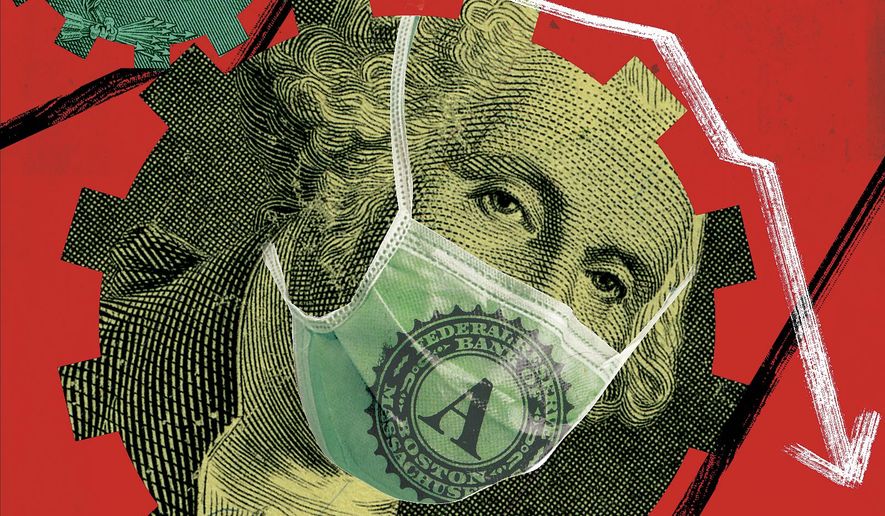OPINION:
Whether it’s President Trump or Joe Biden, the White House — and Federal Reserve — face another tough year in 2021.
Many of Mr. Trump’s COVID-19 policies have worked out — a vaccine should emerge soon in part thanks to federal support to pharmaceutical companies, resources have been marshalled to produce more ventilators and masks, and hospitals are in better shape to cope with the second wave.
Thanks to the CARES Act stimulus payments to households, enhanced unemployment benefits and aid to small businesses and expanded Fed lending programs rebounded more strongly than expected. After contracting at an annual pace of 31.4% in the second quarter, GDP increased an estimated 25% in the third quarter.
However, the stimulus has mostly run its course, household incomes temporarily boosted by those transfer payments are now contracting, and the pace of recovery in consumer spending and employment is slowing.
Record numbers of small businesses, temporarily shuttered, are now permanently closing, and many brick and mortar retailers are in Chapter 11. Venerable corporate names are permanently cutting staff in petroleum, media, airlines, banking, insurance, automotive and elsewhere.
This winter, as a vaccine should be rolling out, the economy will still be about 3% smaller than it would have been without the pandemic, and 4 or 5 million Americans will be added to the rolls of the permanently unemployed.
This second wave of pink slips is more highly concentrated among professional workers — lawyers, bankers, engineers, technicians and managers — whose skills are more industry specific than when they left school and now redundant. For example, where does a pilot or reservation agent permanently separated from Delta Airlines go when United and American also see little prospect for business travel returning to pre-pandemic levels.
Disney is discharging 28,000 workers, because its theme parks are either closed, as in California, or operating at reduced capacity, but this distracts from the studio’s more fundamental problem. The company owns 15 major film franchises, such as Pixar and Indiana Jones, and routinely spends $200 million to produce a movie. Paying for these relies on big theater ticket sales in early weeks after release and the buzz generated driving interest in its streaming service, merchandise, theme parks and resorts.
COVID-19 will close many theaters for good, as consumers increasingly enjoy first runs at home, and studios simply can’t charge as much for per person for home viewing new releases. Movies made exclusively for streaming services have smaller budgets and fewer staff. The long-term prospects for animators, script writers, directors, film editors and highly paid actors just took a big shift down.
What to do with all those disappointed folks—along with petroleum engineers, lawyers and professionals in other industries — is one tough puzzle.
The Fed is not only out of bullets but like Dr Jekyll, has created its own Mr. Hyde. We face stagflation, namely the paradox of high unemployment and inflation.
During May, June and July the CPI rose at a 5% annual pace as compared to the prices the prior three months. We will soon have run the string on lower oil and gas prices and productivity gains and imports keeping down costs for most durable goods, save autos, and consumer items like apparel.
The sorcerers — aka professional economists — employed by Fed Chairman Jerome Powell have causality confused. In their virtual reality manufacturing inflation creates prosperity. Well they had better ask those 5 million structurally unemployed and walk back their policy of printing money with reckless abandon.
Rock-bottom mortgage rates are enabling a real estate rush in distant suburbs and resorts that may soon collapse as offices reopen. Bankers and software engineers who thought they could work full time from Pennsylvania and Nevada may be shopping for apartments in New York and California.
Expanding industries — web-based services, robotics, electric cars and the like — all need workers with skills businesses can’t find. They are suing the Trump administration to open up immigration, because it’s cheaper to import skilled workers than retrain the unemployed.
A national re-employment strategy could offer subsidies to employers to hire and retrain workers, jobless for more than three months and formerly employed in other industries, equal to 25% of their former salaries for two years. And continue unemployment benefits up to an equal amount. Eligible salaries and subsidies could be capped at $200,000 and $50,000.
Expanding the pool of skilled labor in growing industries would both relieve cost and inflationary pressures and provide new opportunities for the structurally unemployed.
• Peter Morici, @pmorici1, is an economist and emeritus business professor at the University of Maryland, and a national columnist.




Please read our comment policy before commenting.